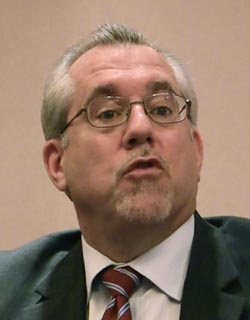GM VP lays out his vision on energy

John Calabrese
On the occasion of the Chevrolet brand’s centennial earlier this month, John Calabrese, General Motor’s vice president of global vehicle engineering, sat down with the Korea JoongAng Daily to lay out his own vision of the future of energy in vehicular propulsion.
Q. GM is working with many different technologies such as electric vehicles, hybrid vehicles and hydrogen fuel cells to provide alternatives to fossil fuels. It is common for global automobile manufacturers to try many different technologies, but there seems to be no convergence to one solution. By when do you think there will be a clear indication of what the future leading technology will be?
A. I don’t know if there ever will be a convergence. Part of it is due to government regulations, and part of it is due to government energy supply. That’s where you have to have a suite of solutions to satisfy markets as diverse as Korea to Brazil.
In Brazil, they have ethanol because [ethanol development] was a government strategy for 20 years to eliminate dependence on imported oil. So now Brazil is an exporter of oil due to its sugar cane and ethanol production.
If you go to Europe, diesel is subsidized. In China, they want to electrify their region, as they want to offset global pollution with energy management of their vehicles.
In Canada, they have a surplus of compressed natural gas, so automakers need a CNG strategy. In Korea, we have liquid propane gas [LPG] used in taxicabs, etc.
That is the challenge of a global economy - each country wants to leverage and use their natural resources in the most efficient way possible.
We need to have solution sets that meet those needs. So in all likelihood, there won’t be a convergence in the next 10 to 15 years. And I say that because we live in a very dynamic world.
Many people doubt that a pure electric vehicle will be the final solution, as electricity is generated by burning fossil fuels. What are your thoughts on that?
If you think of it today, the science behind that line of thought is correct. But one must think of where we’ll be in 2050 and the challenges we’ll have. The urbanization of the world is going to occur, so the demands on your vehicles will be different. The fundamental question is how to meet those new demands. Not all electricity comes from fossil fuels - there’s wind, solar and other ways. But the bigger challenge is trying to maintain the balance between consumer needs, consumer usage and energy availability.
I’ve been to Seoul many times, and traffic is very tough. The challenge is anticipating what the world going to look like in 2050, and what that world is going to demand in methods of moving from point A to point B.
By Lee Jung-yoon [joyce@joongang.co.kr]










with the Korea JoongAng Daily
To write comments, please log in to one of the accounts.
Standards Board Policy (0/250자)